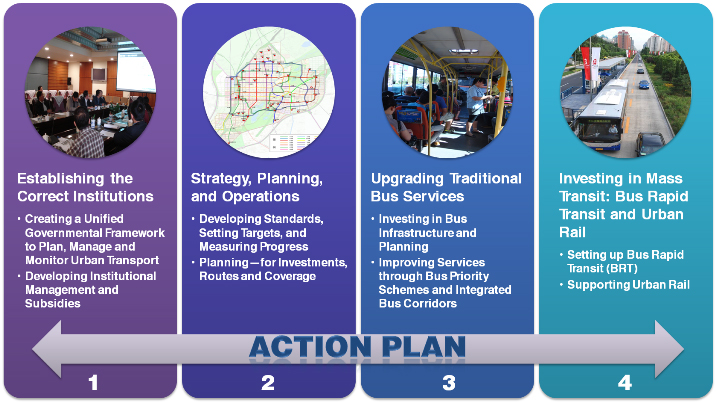Public transport can be a cost-effective and efficient alternative to individual private modes for accessing urban opportunities. In addition, public transport provides a variety of benefits that private automobile transportation cannot: the efficient use of urban space, fewer traffic fatalities, and a reduction in the harmful effects of urban air pollution. This is no less true today than it was in decades past.
What has changed in recent years is that the climate change imperative has further strengthened the attractiveness of public transportation. At reasonable levels of vehicle loading, a bus or metro system can provide far more energy- and carbon-efficient transportation than the average car, per passenger kilometer.
This is the basic argument that supports public transport as an element of a low-carbon city platform—a public transport system can move more people more efficiently and with fewer negative externalities than a private transport system can. However, individual citizens with the freedom to choose their own mode of transport will usually not seek to maximize global environmental benefits. Rather, they will choose a mode that maximizes comfort, reliability, speed, convenience, and cost.
On most of these dimensions, cars are an optimum choice for many commuters; and for reasons of status and function it is common that as incomes rise, those with financial means switch to cars. Chinese cities are currently following this pattern, and rapid economic development has led to a boom in car ownership.
The only public transport alternative for most people is a bus service steadily degraded by ever-increasing traffic congestion. Not surprisingly, for those with a choice, public transport is rarely competitive, and an overwhelming majority of public transport users in Chinese cities today are “captive” users with few alternatives.
However, as economic development continues, today’s captive riders will have choices tomorrow—and only a high-quality system will be able to keep them from choosing individual transportation alternatives. Ultimately, the goal is to provide public transport of quality that not only satisfies the needs of today’s captive users, but also attracts customers away from cars and taxis. Such a public transport system that has the capability to attract customers from private automobiles is often a necessary political prerequisite for cities to consider restrictions on auto use.
All urban strategies for low-carbon growth will require a large share of passenger traffic to be carried by an upgraded public transport system, even as increasing income levels make auto use a viable choice for increasing numbers of people. Naturally, the definition of “upgraded public transport” will vary based on the context; a commuter in Shanghai has different expectations (and the city has different resources) than a commuter in a small city. For this reason, the appropriate program for public transport improvement will vary over time for any given place and will depend on the context.
The national government and urban public transport. In the first two decades after 1977, China’s national government was not much involved in the urban transport sector, considering it a local issue best left to local municipalities. At the highest levels, these policies have begun to change.
In October 2005, a State Council decision declared that urban public transport development should be a national priority. Subsequently, particularly after the responsibility for urban public transport was given to the newly formed Ministry of Transport in 2007, the national government has been actively looking to define its role in this sector.
The current focus is to both (i) define a national policy toward public transport and (ii) review issues related to subsidies and institutions. These developments are timely and will work well to support urban transport and low-carbon developments.
The above graph summarizes the key elements of an action plan that a city could put in place to improve the quality of their urban public transport in a manner that would also lower the total carbon footprint of their transport system. Look for more information: Chapter 11 of Sustainable Low Carbon City book has summarized the range of measures a Chinese city can take to improve the quality and competitiveness of its public transport system.
While solutions are often context-specific and every city will need to find ways to improve public transport based on detailed local needs and conditions, there are broad similarities in the strategies that almost all cities will benefit from following. The following “three-integrations” summarize the key focus areas and challenges facing Chinese cities as they work to develop public transport systems that would support a low-carbon economy:
- Developing customer-oriented services: Modern customer-oriented public transport enterprises can attract users of choice. This will require greater attention to the details of bus and rail transfer facilities, as well as the creation of premium services and a customer-oriented mentality.
- Integrating schedules and fares across modes and services: Although the use of multi-modal smartcards is common, bus interchange facilities that help passengers change modes or services are systematically underused. In addition, fare policies are rarely designed to facilitate intermodal fare transfers. Integrated bus and rail services, schedules, and fares will contribute greatly to improved services for passengers.
- Integrating land use with transport planning: It is increasingly evident that even the most effective systems of public transport cannot be competitive if they are not carefully integrated with land use planning and design.


